 L-1,主要污染物为磺胺甲恶唑、氟罗沙星和强力霉素。沉积物中共检出12种抗生素,总浓度范围为3.46~28.92 ng
L-1,主要污染物为磺胺甲恶唑、氟罗沙星和强力霉素。沉积物中共检出12种抗生素,总浓度范围为3.46~28.92 ng g-1,主要污染物为氟罗沙星。生态风险评估结果表明,水体中检出的抗生素风险商(RQ)值均<1,未发现单一抗生素在各水源地存在高风险。人体健康风险评估结果表明,各水源地中检出的抗生素健康风险商(RQH)值均远<0.01,对成人和儿童健康造成的损害可忽略。
g-1,主要污染物为氟罗沙星。生态风险评估结果表明,水体中检出的抗生素风险商(RQ)值均<1,未发现单一抗生素在各水源地存在高风险。人体健康风险评估结果表明,各水源地中检出的抗生素健康风险商(RQH)值均远<0.01,对成人和儿童健康造成的损害可忽略。目前,抗生素不仅在污水处理厂[1]、医院[2]和水产养殖场[3]等废水中检出抗生素,在海洋、河流[4-7]等自然水体中也广泛存在抗生素的检出。如今,抗生素污染严重威胁到水生态系统和人类健康,已经引起了世界各国的关注。中国抗生素的生产量和使用量一直以来都居于高位[8];2022年,我国发布了《新污染物治理行动方案》,提到对新污染物的监测与治理,加强抗生素研究和管控[9]。在水环境中,饮用水的摄入是抗生素进入人体的重要途径之一,因此饮用水源地中抗生素的残留问题需要引起重视,相关研究已在华东地区[10]、重庆市[11]和南京市[12]等区域的饮用水源地检出抗生素。海南省地处热带的北缘,四面环海,拥有独特的气候条件,是我国重要的农业基地,渔业和畜牧业是其大力发展的产业,以往研究发现制药工业、畜牧业等是抗生素的主要来源,因此在这些产业活动中很可能造成抗生素的大量排放[13],其残留问题不容忽视。但是目前尚缺乏有关海南省饮用水源地抗生素的污染研究。本研究主要揭示海南省典型饮用水源地抗生素在水体和底泥沉积物中的残留水平,并初步评价水体中抗生素对生态和人体造成的风险。
1.1.1 实验仪器
AB SCIEX API4000三重四级杆质谱仪(Applied Biosystems,美国)、Agilent 1260液相色谱仪(安捷伦,美国)、2600TH超声机(上海安谱实验科技,中国)、N-EVAP 112氮吹仪(Organomation,美国)、Sorvall ST 40R离心机(赛默飞,美国)、Visiprep DL 12管防交叉污染固相萃取装置(北京普立泰科公司,中国)。
1.1.2 试剂
本研究的目标化合物的基本信息如表1所示。乙腈(色谱纯,默克)、CNWBOND LC-C18 SPE填料(40~63 μm,上海安谱实验科技)、CNWBOND PSA PAEs QuEChERS专用填料(40~63 μm,上海安谱实验科技)、柠檬酸钠缓冲溶液(0.1 mol L-1,上海源叶生物科技有限公司)、无水硫酸钠(≥99%,国药集团化学试剂有限公司)、氯化钠(分析纯,上海阿拉丁生化科技股份有限公司)、甲酸(≥98%,上海安谱实验科技)、乙二胺四乙酸二钠(99%~101%,上海麦克林生化科技有限公司)、抗生素标准品、氘代同位素标准品d4-SMR、d3-LIM、d4-SMX、d3-TMP、d8-CFX、d4-TBD(>98%,百灵威科技有限公司)。
L-1,上海源叶生物科技有限公司)、无水硫酸钠(≥99%,国药集团化学试剂有限公司)、氯化钠(分析纯,上海阿拉丁生化科技股份有限公司)、甲酸(≥98%,上海安谱实验科技)、乙二胺四乙酸二钠(99%~101%,上海麦克林生化科技有限公司)、抗生素标准品、氘代同位素标准品d4-SMR、d3-LIM、d4-SMX、d3-TMP、d8-CFX、d4-TBD(>98%,百灵威科技有限公司)。
于2021年4月采集海南省5个典型饮用水源地表层水过滤后的水相和沉积物样品。考虑到海南省饮用水源地的分布情况和典型性,本研究选取了5个集中式生活饮用水源地一级保护区(L1、S1、H1、D1、Y1);二级保护区(L2、S2、H2、D2、Y2);准保护区(L3、S3、H3、D3、Y3)设置采样点,采样位点分布及土地利用情况如图1所示。水样采集于同一水平面0.5 m以下;使用不锈钢采水器采集3个点水样,将其混合,取1 L置于宽口棕色玻璃瓶中保存。使用抓斗式采泥器在水样采集点周围等距离采集沉积物样品,每个沉积物由3个样均匀混合而成;采集后沥水除杂,取1 kg左右置于棕色广口玻璃瓶,瓶盖内衬洁净锡箔纸。样品尽快运回实验室,水样在4 ℃冰箱保存,沉积物样品在-80 ℃下冷冻干燥,研磨成细小颗粒后放置于-20 ℃冰箱保存。
表1 目标化合物的基本信息
Table 1 Basic information about the target compounds

中文名称Chinese name英文名称English name简称AbbreviationCAS No.分子式Molecular formula分子量Molecular weightlogKowa磺胺类抗生素(Sulfonamides, SAs)磺胺嘧啶SulfadiazineSDZ68-35-9C10H10N4O2S250.28-0.09磺胺吡啶SulfapyridineSPD144-83-2C11H11N3O2S249.290.35磺胺甲恶唑SulfamethoxazoleSMX723-46-6C10H11N3O3S253.280.89磺胺间甲氧嘧啶SulfamonomethoxineSMM1220-83-3C11H12N4O3S280.30—磺胺氯哒嗪SulfachloropyridazineSCP80-32-0C10H9ClN4O2S284.72—磺胺喹喔啉SulfaquinoxalineSQ59-40-5C14H12N4O2S300.34—磺胺二甲嘧啶SulfamethazineSMZ57-68-1C12H14N4O2S278.330.80磺胺醋酰SulfacetamideSCT144-80-9C8H10N2O3S214.24—磺胺SulfanilamideSA63-74-1C6H8N2O2S172.20-0.62b磺胺噻唑SulfathiazoleSTZ72-14-0C9H9N3O2S2255.320.05磺胺对甲氧嘧啶SulfameterSMD651-06-9C11H12N4O3S280.300.42b磺胺二甲氧哒嗪SulfadimethoxineSDM122-11-2C12H14N4O4S310.33—喹诺酮类抗生素(Quinolones, QNs)马波沙星MarbofloxacinMAR115550-35-1C17H19FN4O4362.36—氟罗沙星FleroxacinFLX79660-72-3C17H18F3N3O3369.34—氧氟沙星OfloxacinOFX82419-36-1C18H20FN3O4361.37-0.39诺氟沙星NorfloxacinNFX70458-96-7C16H18FN3O3319.330.46环丙沙星CiprofloxacinCFX85721-33-1C17H18FN3O3331.340.28诺美沙星LomefloxacinLOM98079-51-7C17H19F2N3O3351.35-0.30c恩诺沙星EnrofloxacinEFX93106-60-6C19H22FN3O3359.390.58沙拉沙星SarafloxacinSAR98105-99-8C20H17F2N3O3385.36—二氟沙星DifloxacinDIF98106-17-3C21H19F2N3O3399.39—达诺沙星DanofloxacinDAN112398-08-0C19H20FN3O3357.381.85b培氟沙星PefloxacinPEF70458-92-3C17H20FN3O3333.36—卡巴多ArbadoxCAR6804-07-5C11H10N4O4262.22—四环素类(Tetracyclines, TCs)土霉素OxytetracyclineOTC79-57-2C22H24N2O9460.43-0.90四环素TetracyclineTC60-54-8C22H24N2O8444.43-1.37氯四环素ChlortetracyclineCTC57-62-5C22H23ClN2O8478.88-0.62强力霉素DoxycyclineDC564-25-0C22H24N2O8444.430.63大环内酯类(Macrolides, MLs)脱水红霉素Erythromycin-H2OETM-H2O23893-13-2C37H65NO12715.91—罗红霉素RoxithromycinRTM80214-83-1C41H76N2O15837.051.70竹桃霉素Oleandomycin phosphateODM7060-74-4C35H64NO16P785.85—其他类(Others)林可霉素LincomycinLIN154-21-2C18H34N2O6S406.540.20甲氧苄啶TrimethoprimTMP738-70-5C14H18N4O3290.320.91
注:— 无参考数据;a数据来源于文献[14];b数据来源于文献[15];c数据来源于文献[16]。
Note: — means there is currently no reference dose; a data from the literature [14]; b data from the literature [15]; c data from the literature [16].
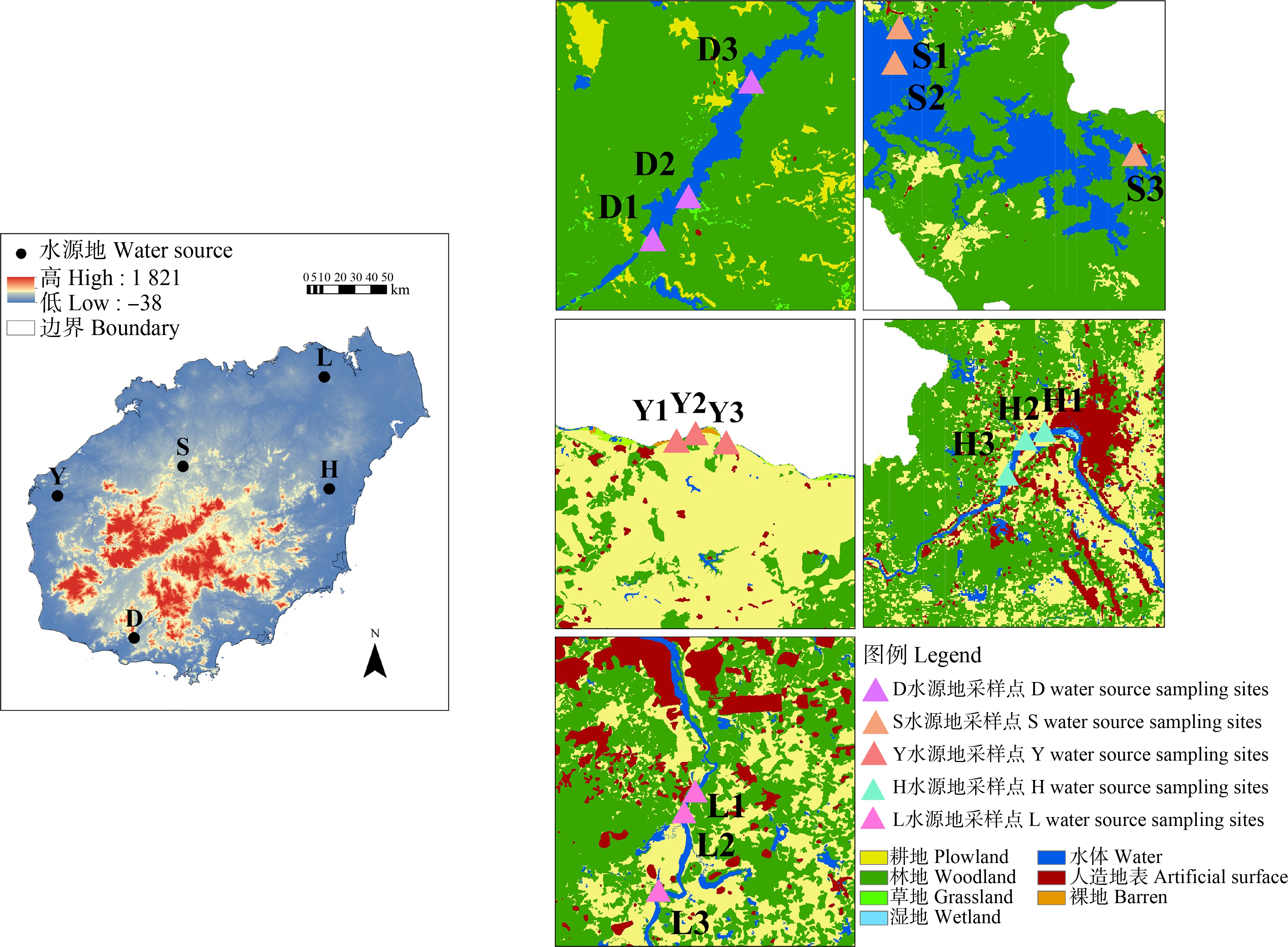
图1 采样点分布图
注:数据来源于国家基础地理信息中心全球地表覆盖数据产品服务网站(DOI: 10.11769)。
Fig. 1 Distribution of sampling sites
Note: According to the data from the National Basic Geographic Information Center Global Land Coverage Data Product Service website (DOI: 10.11769).
1 L水样中加入0.5 g乙二胺四乙酸二钠(Na2EDTA)及内标混合溶液。用10 mL甲醇和超纯水依次活化HLB小柱,再将水样过柱。上样完成后,用10 mL超纯水对小柱进行淋洗,经真空干燥1 h后,用10 mL甲醇洗脱HLB小柱,将洗脱液接至新的玻璃离心管中,氮吹近干后,甲醇复溶,并通过0.22 μm滤膜转移至棕色进样瓶,用液相色谱质谱联用(LC-MS/MS)进行上机检测。
1.3.2 沉积物样品
参考了以往研究对固相基质中抗生素检测的方法[17-18],称取5 g沉积物样品,加入0.4 g Na2EDTA、5 mL柠檬酸钠缓冲液及内标混合溶液,置4 ℃冰箱过夜。次日加入10 mL 5%甲酸化乙腈,涡旋振荡后,超声15 min。加4 g无水硫酸钠及1 g氯化钠,涡旋振荡3 min,以8 000 r min-1,4 ℃,离心5 min,室温静置后,移取上清液至填装有50 mg PSA、150 mg C18、900 mg无水硫酸钠的净化管中,涡旋振荡3 min后,以5 000 r
min-1,4 ℃,离心5 min,室温静置后,移取上清液至填装有50 mg PSA、150 mg C18、900 mg无水硫酸钠的净化管中,涡旋振荡3 min后,以5 000 r min-1、4 ℃,离心5 min,移取上清液至试管,氮吹近干后,加入初始流动相复溶,并通过0.22 μm滤膜转移至棕色进样瓶,用液相色谱质谱联用(LC-MS/MS)进行上机检测。
min-1、4 ℃,离心5 min,移取上清液至试管,氮吹近干后,加入初始流动相复溶,并通过0.22 μm滤膜转移至棕色进样瓶,用液相色谱质谱联用(LC-MS/MS)进行上机检测。
色谱条件:色谱柱为Poroshell 120 EC-C18(4.6 mm×50 mm, 2.7 μm),柱温为40 ℃,进样体积5 μL,流速0.3 mL·min-1。流动相A为乙腈,流动相B为0.05%甲酸和2 mmol L-1乙酸胺,流动相梯度洗脱条件为:2 min时流动相A和流动相B的比例从15/85换为40/60,4 min时换为60/40,在9.1 min时换为15/85,洗脱至13 min时结束。
L-1乙酸胺,流动相梯度洗脱条件为:2 min时流动相A和流动相B的比例从15/85换为40/60,4 min时换为60/40,在9.1 min时换为15/85,洗脱至13 min时结束。
质谱条件:采用离子电喷雾正离子(ESI+),多反应监测(MRM)模式。离子源温度325 ℃;离子喷雾电压5 801 V。
样品的定量分析是采用内标法,选用10个点的校正曲线进行定量,标准曲线梯度为0.2、0.5、2、5、10、20、50、100、200和500 μg·L-1,呈现了较好的线性关系(r>0.995)。设置空白、空白加标和基质加标保证检测方法的可行性,分别采用与水样和沉积物样品相同的方法分析3个空白加标样品和3个基质加标样品。水样和沉积物的目标物质回收率分别为45%~145%和40%~141%。本研究中,PEF的回收率达141%,内标响应较好,但回标响应偏低,考虑是基质效应导致的抗生素的回收率偏高。水样和沉积物的检出限范围分别为0.008~6.83 pg·L-1和0.002~7.09 pg·g-1。
1.6.1 生态风险评估
本研究根据风险评估技术指导文件[19],选择了风险商值法(RQ)对海南省典型饮用水源地进行生态风险评估[20]。计算公式如下:
式中:MEC为测定环境浓度(ng·L-1),选择实测抗生素浓度的最大值。PNEC为预测无效应浓度(ng·L-1),数据来源于文献报道,选择最敏感物种的PNEC值[21-26],由于MAR、FLX和SMM缺乏毒性数据,无法获得PNEC值,未进行生态风险评估。低风险水平:0.01≤RQ<0.1;中风险水平:0.1≤RQ<1;高风险水平:RQ≥1[27]。
1.6.2 健康风险评估
本研究评估海南省典型水源地水体中抗生素对不同年龄组人群的健康风险,主要考虑饮水途径摄入污染物的健康风险商值,以量化评估水体中抗生素污染对不同年龄组人群健康的影响,计算公式如下:
式中:MEC为抗生素的测定浓度(μg·L-1),考虑到最大风险控制原则,因此选择实测抗生素的最大浓度值,DWEL为每升饮用水中抗生素的当量值(μg·L-1)。DWEL的计算公式如下:
式中:ADI是日均可接受摄入量(μg·kg-1·d-1),数据来源于文献[28-29];HQ是最高风险,按1计算;AB是胃肠吸收率,按1计算;FOE是暴露频率(350 d·a-1),按0.96计算;BW是人均体质量(kg) ;DWI是每日饮水量(L·d-1)。BW和DWI数据来源于中国人群暴露参数手册[30-31]。当RQH<0.01时,风险水平可忽略不计;当0.01
使用IBM SPSS Statistics 26进行相关性分析,运用斯皮尔曼相关系数,对不同环境介质中抗生素浓度之间的关系进行讨论。
本研究所分析的33种抗生素,在水体中共有9种抗生素被不同程度检出,如图2(a)所示,包括1种其他类、1种MLs、3种QNs、1种TCs以及3种SAs,总浓度范围为2.48~112.87 ng·L-1,平均浓度为33.92 ng·L-1,中值为20.47 ng·L-1。本研究水体中检出浓度较高的抗生素依次为SMX、FLX和DC,检出率分别为52%、100%和22%。与我国其他水源地相比,如表2所示,本研究水源地水体中SMX的浓度水平较华东地区水源地、长江三角洲水库低,较江苏骆马湖流域水源地、长江中游水源地高;FLX的浓度水平较南京水源地高;DC的浓度水平与长江下游地区水源地相近,较枫树坝水库低,但较南京水源地高。因此本研究水体中检出的抗生素浓度水平与国内的其他水源地相比,其污染水平处于中等偏低,且其也远低于国内外河流的浓度水平。
在沉积物中共检出12种抗生素,如图2(b)所示,包括6种QNs、3种TCs、1种SAs、1种MLs以及1种其他类抗生素,总浓度范围为3.46~28.92 ng·g-1,单种抗生素的浓度范围为ND~10.33 ng·g-1,平均浓度为14.92 ng·g-1,中值为12.85 ng·g-1。本研究沉积物中抗生素的浓度水平结果低于中国典型湖泊[33](单种抗生素浓度范围为ND~2 663 ng·g-1)、美国Cache La Poudre河[34](单种抗生素浓度范围为1~102.70 ng·g-1)、南非Msunduzi河[35](单种抗生素浓度范围为ND~125.35 ng·g-1)。而与白洋淀(单种抗生素浓度范围为ND~52.89 ng·g-1)[36]的研究结果相似,因此本研究沉积物中抗生素的污染处于低水平。检出的抗生素中检出率高于或等于50%的有FLX、EFX、OFX、CFX、NFX、DC和ETM-H2O,而MAR、OTC、CTC、SMX和LIN的检出率低于50%。其中QNs的浓度水平均较高,FLX的浓度水平最高,浓度范围为ND~10.33 ng·g-1,平均浓度为5.66 ng·g-1,与白洋淀[37]的研究结果相近。

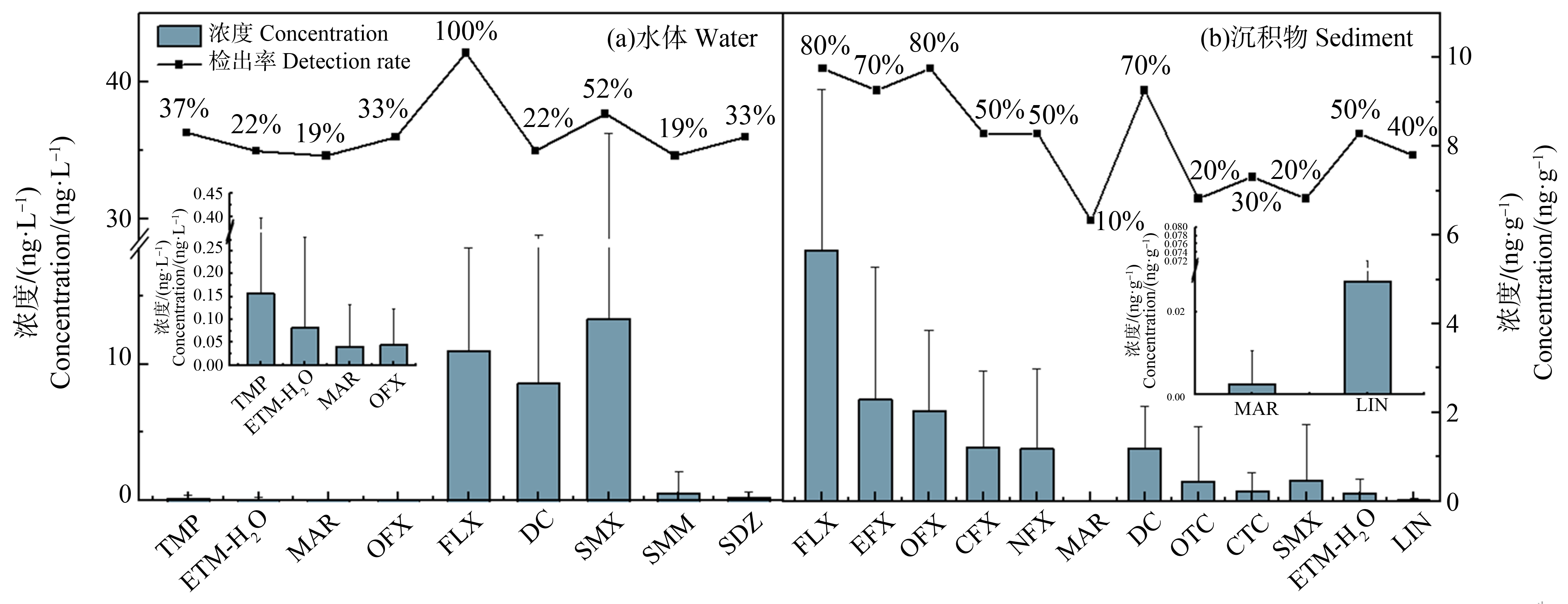
图2 抗生素在水体(a)和沉积物(b)中的浓度水平和检出率
Fig. 2 Concentration levels and detection rates of antibiotics in water bodies (a) and sediments (b)
水源地的一级保护区离取水口最近,需要特别关注。由于未取得D水源地的一级保护区沉积物样品,因此仅对Y、H、S和L水源地的一级保护区进行分析。如图3所示,水体中检出抗生素的浓度高于沉积物中的浓度,但检出种类较沉积物中少。水体中,TCs仅检出了DC,而沉积物中除了DC,还检出OTC、CTC,但浓度水平低于水体。水体中,SMX的检出浓度较高,但在沉积物中未检出。由图4可知,QNs在这2种环境介质中浓度水平相近,但沉积物中的抗生素种类仍比水体中多。FLX在各水源地均有检出,在水体和沉积物中浓度水平均高于其他抗生素。其次OFX在各水源地沉积物中均有检出,浓度水平较低。
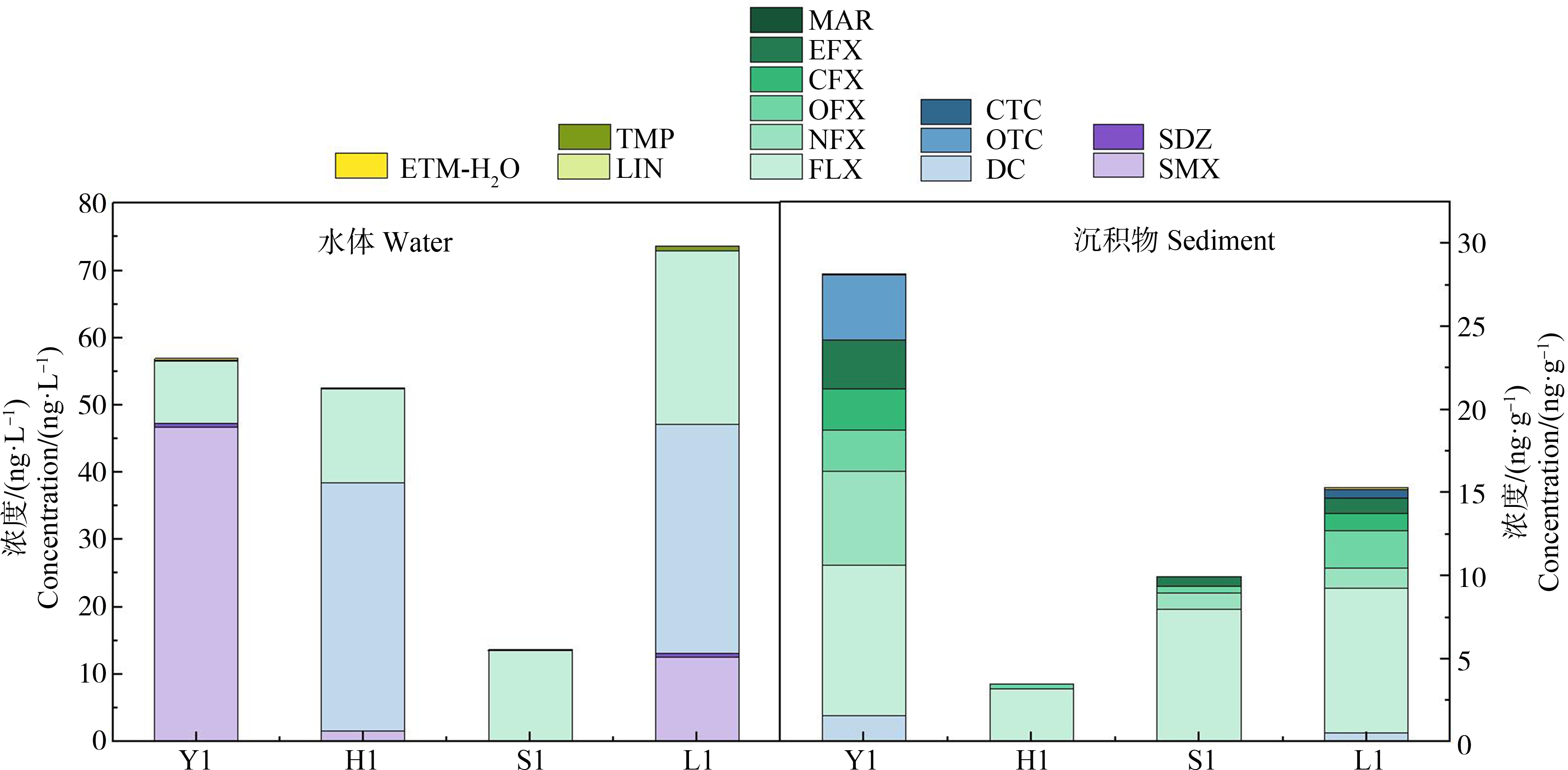
图3 饮用水源地一级保护区中抗生素在水体和沉积物的浓度
Fig. 3 Concentrations of antibiotics in water bodies and sediments in primary protection areas of drinking water sources

图4 饮用水源地一级保护区中QNs在水体和沉积物的浓度
Fig. 4 Concentrations of QNs in water bodies and sediments in primary protection areas of drinking water sources
对抗生素之间的相关性进行了统计学分析,如表3和表4所示。检出浓度较高的SMX、OFX和DC在水体和沉积物中的相关性不同。在水体中SMX与其他2种抗生素无相关性,而DC与FLX呈显著性相关(r=-0.552,P=0.003,P<0.01)。在沉积物中,这3种抗生素之间均无相关性,说明不同环境介质中抗生素之间的相关性不同。对水体中抗生素与沉积物中抗生素之间的相关性进行了统计学分析,如表5所示。水体中SMX与沉积物中OFX具有相关性(r=0.659,P=0.038,P<0.05)。SMX在水体中常被检出,且浓度水平较高。其与OFX一样,为广谱抗菌药,两者常被用于临床上感染性疾病,对大肠杆菌和葡萄球菌均有较好的抗菌作用。有研究发现,OFX可能会对SMX的光化学转化产生影响[49]。
表3 水体中不同抗生素之间的相关性
Table 3 Correlations between different antibiotics in water bodies

SDZSMMSMXTMPMARFLXOFXDCETM-H2OSDZ1.000SMM0.468*1.000SMX0.820**0.2921.000TMP0.1150.084-0.0101.000MAR-0.326-0.224-0.3330.0121.000FLX-0.124-0.1500.0610.0250.0051.000OFX-0.212-0.145-0.126-0.071-0.1510.0791.000DC-0.364-0.0500.097-0.0150.0180.552**0.1051.000ETM-H2O0.526**-0.0230.624**-0.286-0.251-0.2050.170-0.2801.000
注:*在0.05级别(双尾),相关性显著;**在0.01级别(双尾),相关性显著。
Note: *at the 0.05 level (two-tailed), the correlation was significant; **at the 0.01 level (two-tailed), the correlation was significant.
表4 沉积物中不同抗生素之间的相关性
Table 4 Correlations between different antibiotics in sediments
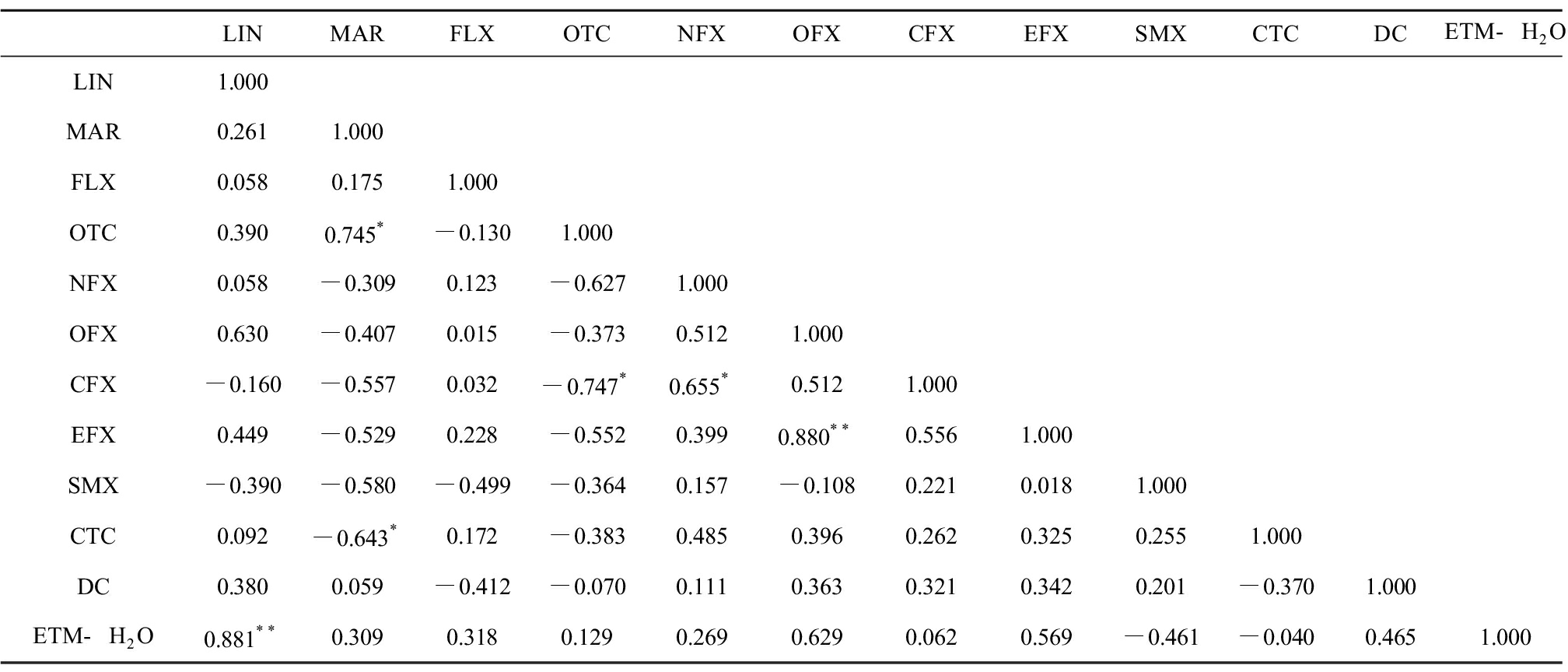
LINMARFLXOTCNFXOFXCFXEFXSMXCTCDCETM-H2OLIN1.000MAR0.2611.000FLX0.0580.1751.000OTC0.3900.745*-0.1301.000NFX0.058-0.3090.123-0.6271.000OFX0.630-0.4070.015-0.3730.5121.000CFX-0.160-0.5570.032-0.747*0.655*0.5121.000EFX0.449-0.5290.228-0.5520.3990.880**0.5561.000SMX-0.390-0.580-0.499-0.3640.157-0.1080.2210.0181.000CTC0.092-0.643*0.172-0.3830.4850.3960.2620.3250.2551.000DC0.3800.059-0.412-0.0700.1110.3630.3210.3420.201-0.3701.000ETM-H2O0.881**0.3090.3180.1290.2690.6290.0620.569-0.461-0.0400.4651.000
注:*在0.05级别(双尾),相关性显著;**在0.01级别(双尾),相关性显著。
Note: *at the 0.05 level (two-tailed), the correlation was significant; **at the 0.01 level (two-tailed), the correlation was significant.
2.3.1 生态风险评估
以往有研究表明,水体中的抗生素残留可能会对生态系统的结构和功能产生影响[50-51],造成一定损害,因此有必要进行生态风险评估。如图5所示,各水源地中SDZ、TMP和SMX的RQ均<0.01,表明这几种抗生素对生态造成的风险可忽略不计。OFX在Y、S和D位点中的RQ<0.1,>0.01,表明这3个饮用水源地中的OFX污染处于低风险水平。L和H中检出的DC的RQ<1,>0.1,处于中等风险,表明其可能是这2个水源地生态风险的主要贡献者。
表5 水体与沉积物中不同抗生素之间的相关性
Table 5 Correlations between different antibiotics in water and sediments
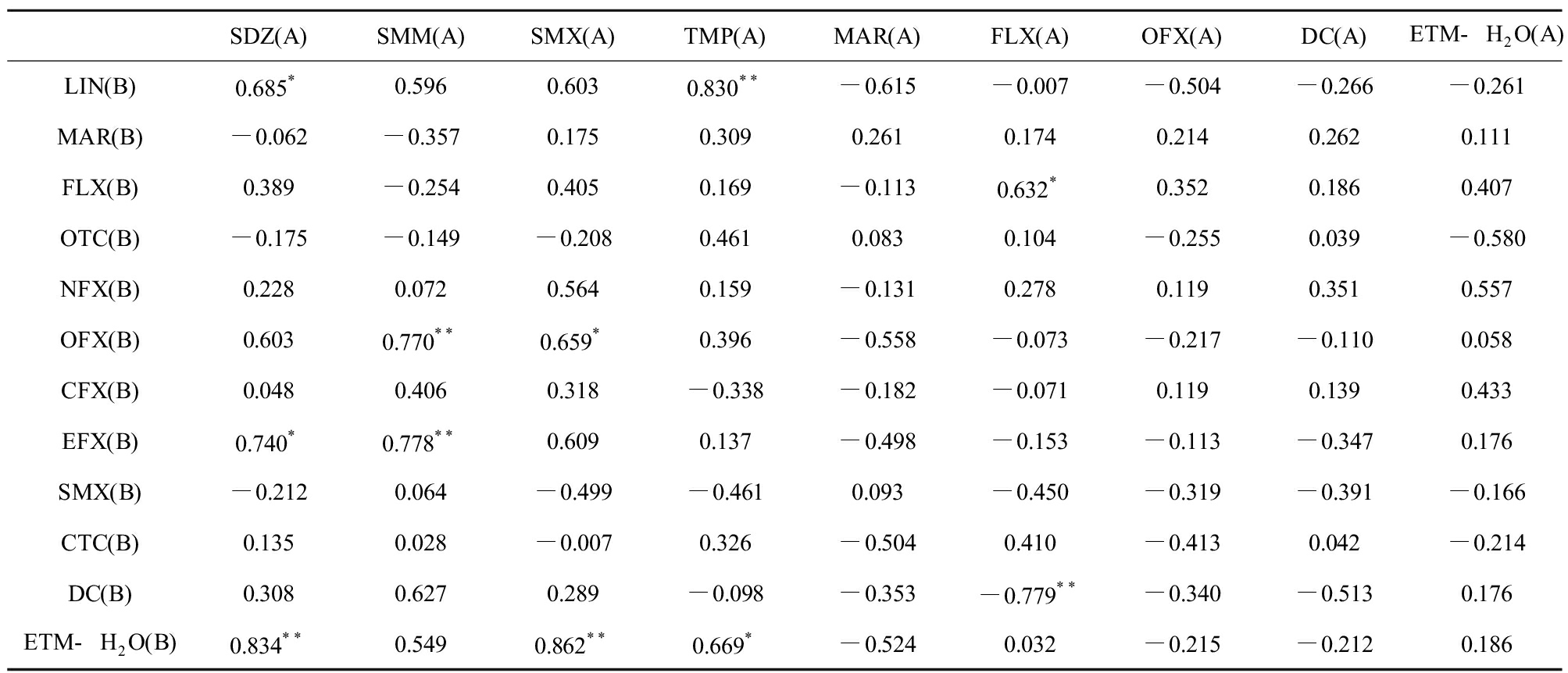
SDZ(A)SMM(A)SMX(A)TMP(A)MAR(A)FLX(A)OFX(A)DC(A)ETM-H2O(A)LIN(B)0.685*0.5960.6030.830**-0.615-0.007-0.504-0.266-0.261MAR(B)-0.062-0.3570.1750.3090.2610.1740.2140.2620.111FLX(B)0.389-0.2540.4050.169-0.1130.632*0.3520.1860.407OTC(B)-0.175-0.149-0.2080.4610.0830.104-0.2550.039-0.580NFX(B)0.2280.0720.5640.159-0.1310.2780.1190.3510.557OFX(B)0.6030.770**0.659*0.396-0.558-0.073-0.217-0.1100.058CFX(B)0.0480.4060.318-0.338-0.182-0.0710.1190.1390.433EFX(B)0.740*0.778**0.6090.137-0.498-0.153-0.113-0.3470.176SMX(B)-0.2120.064-0.499-0.4610.093-0.450-0.319-0.391-0.166CTC(B)0.1350.028-0.0070.326-0.5040.410-0.4130.042-0.214DC(B)0.3080.6270.289-0.098-0.353-0.779**-0.340-0.5130.176ETM-H2O(B)0.834**0.5490.862**0.669*-0.5240.032-0.215-0.2120.186
注:*在0.05级别(双尾),相关性显著;**在0.01级别(双尾),相关性显著;A表示水体中的抗生素;B表示沉积物中的抗生素。
Note: * at the 0.05 level (two-tailed), the correlation was significant; **at the 0.01 level (two-tailed), the correlation was significant; A indicates antibiotics in water bodies; B indicates antibiotics in sediments.

图5 海南省典型饮用水源地抗生素的生态风险
Fig. 5 The ecological risk of antibiotics in typical drinking water sources in Hainan Province
2.3.2 健康风险评价
饮用水是抗生素进入人体的重要途径,对人体健康具有潜在损害;因此,对饮用水源地中抗生素的人体健康风险进行评价具有重要意义。由于MAR、FLX、SMM、ETM-H2O、TMP缺乏ADI数据,无法计算DWEL值,未对其进行健康风险评估。选择水体中抗生素检出的最高浓度计算各水源地对人体健康的RQH值,如图6所示,各水源地中检出的SDZ、SMX、OFX和DC的RQH均远<0.01,表明在各水源地中这4种抗生素对各年龄组人群健康造成的风险水平可忽略。该结果与华东地区[10]、东莞市[52]、三峡库区[53]等地区的饮用水源地健康风险评价的结果相似。抗生素对不同年龄段的风险从出生开始逐渐增大,到9~24个月达到最大,然后降低,在15~18岁达到最低,最后从18岁开始随着年龄的增长,风险商基本保持不变。不考虑各抗生素复合作用的情况下,将几种抗生素的风险商值进行加和,水体中抗生素对不同年龄段人群的总健康风险商均远<0.01,引起的健康风险可忽略。
本研究各水源地中同时检出了多种抗生素,提示抗生素可能存在复合污染。据美国食品和药品管理局报道,SMX在中国的产量位居世界前列,使用量也是最高的[54]。在SAs中,SMX具有难降解性和较高的水溶性,因此在以往研究中常常具有较高的检出率和浓度。水体中,Y1的SMX高于其他位点,SMX是兽用抗生素,常被用于养殖业[13, 55],Y1周围分布有村庄,因此农业可能是其潜在的污染来源。TCs由于价格低廉,被广泛用作药物添加剂、运用于医疗和养殖等方面[13],DC在H1和L1的浓度水平高于其他位点,2个位点间具有相似的特点,它们周边的人造地表面积较大,分布有大量的村庄、城镇、农场,人口密集,生活污水、养殖废水可能是其主要的污染来源。S1抗生素浓度水平较低,可能是由于其污染来源较少。抗生素在水体与沉积物中的分布有差异,可能是由于抗生素本身的性质、环境行为和生产活动等因素造成。沉积物中抗生素浓度低于水体,除QNs与水体中浓度水平相近外,这可能是由于QNs与阳离子的螯合作用强,导致其在沉积物中降解缓慢。

图6 海南省典型饮用水源地抗生素的人体健康风险评价
Fig. 6 Human health risk assessment of antibiotics in typical drinking water sources in Hainan Province
本研究抗生素的生态风险评价结果,与其他饮用水源地[36]相似,未出现高风险水平。SMX在水体中的浓度水平较其他抗生素高,但仍处于低风险水平,可能是由于其毒性较低,但这仅是对单一抗生素生态风险评价,联合风险也不容忽视,应进一步研究分析。各水源地中抗生素的健康风险可忽略,残留抗生素对人体健康未造成直接风险,且均为痕量水平,但长期持续暴露,也可能会导致其在人体内逐渐蓄积,对人体健康造成潜在损害,需引起持续关注。运用风险商值法评价单一抗生素对生态、人体造成的风险具有一定参考价值,但是仍存在局限性;如无法评价污染物在人体内长期蓄积可能造成的健康损害,未评价多种污染物的混合效应,因此环境中抗生素的残留问题仍需关注。
综上所述:(1)在海南省典型饮用水源地水体和沉积物检出的抗生素中,QNs浓度和检出率较高,其中浓度最高的均是FLX;(2)各水源地沉积物和水体中检出的抗生素种类和浓度可能会受其他因素影响,造成抗生素污染分布差异。(3)各水源地抗生素的生态风险及健康风险均未出现高风险水平,风险商值法评价抗生素对生态、人体造成的风险具有一定局限,抗生素的潜在损害需引起持续关注。
[1] Gao L H, Shi Y L, Li W H, et al. Occurrence of antibiotics in eight sewage treatment plants in Beijing, China [J]. Chemosphere, 2012, 86(6): 665-671
[2] 张秀蓝, 张烃, 董亮, 等. 固相萃取/液相色谱-串联质谱法检测医院废水中21种抗生素药物残留[J]. 分析测试学报, 2012, 31(4): 453-458
Zhang X L, Zhang T, Dong L, et al. Determination of antibiotics in hospital wastewater using HPLC-MS/MS coupled with solid phase extraction [J]. Journal of Instrumental Analysis, 2012, 31(4): 453-458 (in Chinese)
[3] 张烜瑞. 山东半岛海水养殖场中抗生素在不同养殖阶段的分布与生物积累特征[D]. 济南: 山东大学, 2021: 1-90
Zhang H R. The distribution and bioaccumulation characteristics of antibiotics in different aquaculture stages in Shandong peninsula mariculture farms [D]. Jinan: Shandong University, 2021: 1-90 (in Chinese)
[4] Li S, Shi W Z, Liu W, et al. A duodecennial national synthesis of antibiotics in China’s major rivers and seas (2005-2016) [J]. The Science of the Total Environment, 2018, 615: 906-917
[5] Ci M W, Zhang G D, Yan X S, et al. Occurrence of antibiotics in the Xiaoqing River Basin and antibiotic source contribution: A case study of Jinan City, China [J]. Environmental Science and Pollution Research International, 2021, 28(20): 25241-25254
[6] Wang C, Zhao Y P, Liu S, et al. Contamination, distribution, and risk assessment of antibiotics in the urban surface water of the Pearl River in Guangzhou, South China [J]. Environmental Monitoring and Assessment, 2021, 193(2): 98
[7] Wang L F, Li H, Dang J H, et al. Occurrence, distribution, and partitioning of antibiotics in surface water and sediment in a typical tributary of Yellow River, China [J]. Environmental Science and Pollution Research International, 2021, 28(22): 28207-28221
[8] Zhu Y G, Johnson T A, Su J Q, et al. Diverse and abundant antibiotic resistance genes in Chinese swine farms [J]. Proceedings of the National Academy of Sciences of the United States of America, 2013, 110(9): 3435-3440
[9] 中华人民共和国国务院办公厅. 新污染物治理行动方案[R]. 北京: 国务院办公厅, 2022
[10] Hu Y R, Jin L, Zhao Y, et al. Annual trends and health risks of antibiotics and antibiotic resistance genes in a drinking water source in East China [J]. The Science of the Total Environment, 2021, 791: 148152
[11] Feng L, Cheng Y R, Zhang Y Y, et al. Distribution and human health risk assessment of antibiotic residues in large-scale drinking water sources in Chongqing area of the Yangtze River [J]. Environmental Research, 2020, 185: 109386
[12] Liu Y H, Chen Y, Feng M J, et al. Occurrence of antibiotics and antibiotic resistance genes and their correlations in river-type drinking water source, China [J]. Environmental Science and Pollution Research International, 2021, 28(31): 42339-42352
[13] Zhang Q Q, Ying G G, Pan C G, et al. Comprehensive evaluation of antibiotics emission and fate in the river basins of China: Source analysis, multimedia modeling, and linkage to bacterial resistance [J]. Environmental Science & Technology, 2015, 49(11): 6772-6782
[14] 于云江, 严骁, 石运刚, 等. 典型流域抗生素调查与排放量估算 以长江流域重庆段为例[M]. 北京: 中国环境出版集团, 2021: 1
[15] 姚宏, 孙佩哲. 抗生素污染控制技术与原理[M]. 北京: 科学出版社, 2020: 10
[16] Anh H Q, Le T P Q, da le N, et al. Antibiotics in surface water of East and Southeast Asian countries: A focused review on contamination status, pollution sources, potential risks, and future perspectives [J]. Science of the Total Environment, 2021, 764: 142865
[17] 孟明辉, 贺泽英, 徐亚平, 等. QuEChERS方法结合高效液相色谱-串联质谱法同时测定土壤中20种抗生素[J]. 农业环境科学学报, 2017, 36(8): 1672-1679
Meng M H, He Z Y, Xu Y P, et al. Simultaneous extraction and determination of antibiotics in soils using a QuEChERS-based method and liquid chromatography-tandem mass spectrometry [J]. Journal of Agro-Environment Science, 2017, 36(8): 1672-1679 (in Chinese)
[18] 李涛, 王策, 徐兆安, 等. 基于分散固相萃取-超高效液相色谱串联质谱法测定沉积物中大环内酯类抗生素[J]. 环境化学, 2022, 41(1): 231-240
Li T, Wang C, Xu Z A, et al. Determination of macrolide antibiotics in the sediment based on dispersed solid-phase extraction coupled with ultra performance liquid chromatography-electrospray ionization tandem mass spectrometry [J]. Environmental Chemistry, 2022, 41(1): 231-240 (in Chinese)
[19] European Commission. European Commission technical guidance document in support of Commission Directive 93/67/EEC on Risk assessment for new notified substances and Commission Regulation (EC) No.1488/94 on risk assessment for existing substance, part Ⅱ [R]. Brussel: European Commission Joint Research Centre, 2003: 100-103
[20] Papageorgiou M, Zioris I, Danis T, et al. Comprehensive investigation of a wide range of pharmaceuticals and personal care products in urban and hospital wastewaters in Greece [J]. Science of the Total Environment, 2019, 694: 133565
[21] Eguchi K, Nagase H, Ozawa M, et al. Evaluation of antimicrobial agents for veterinary use in the ecotoxicity test using microalgae [J]. Chemosphere, 2004, 57(11): 1733-1738
[22] 应光国, 彭平安, 赵建亮. 流域化学品生态风险评价以东江流域为例[M]. 北京: 科学出版社, 2012: 183
[23] Backhaus T, Scholze M, Grimme L H. The single substance and mixture toxicity of quinolones to the bioluminescent bacterium Vibrio fischeri [J]. Aquatic Toxicology, 2000, 49(1-2): 49-61
[24] Brain R A, Johnson D J, Richards S M, et al. Effects of 25 pharmaceutical compounds to Lemna gibba using a seven-day static-renewal test [J]. Environmental Toxicology and Chemistry, 2004, 23(2): 371-382
[25] Halling-Sørensen B, Lützhøft H C, Andersen H R, et al. Environmental risk assessment of antibiotics: Comparison of mecillinam, trimethoprim and ciprofloxacin [J]. The Journal of Antimicrobial Chemotherapy, 2000, 46(Suppl 1): 53-58
[26] Lützhøft H H, Halling-Sørensen B, Jørgensen S E. Algal toxicity of antibacterial agents applied in Danish fish farming [J]. Archives of Environmental Contamination and Toxicology, 1999, 36(1): 1-6
[27] Hernando M D, Mezcua M, Fernández-Alba A R, et al. Environmental risk assessment of pharmaceutical residues in wastewater effluents, surface waters and sediments [J]. Talanta, 2006, 69(2): 334-342
[28] Hanna N D, Sun P, Sun Q, et al. Presence of antibiotic residues in various environmental compartments of Shandong Province in Eastern China: Its potential for resistance development and ecological and human risk [J]. Environment International, 2018, 114: 131-142
[29] Wang H X, Yang J Q, Yu X, et al. Exposure of adults to antibiotics in a Shanghai suburban area and health risk assessment: A biomonitoring-based study [J]. Environmental Science & Technology, 2018, 52(23): 13942-13950
[30] 段小丽. 中国人群暴露参数手册(儿童卷)概要[M]. 北京: 中国环境出版社, 2016: 38-166
[31] 中华人民共和国环境保护部. 中国人群暴露参数手册(成人卷)[M]. 北京: 中国环境出版社, 2013:45-764
[32] 李辉, 陈瑀, 封梦娟, 等. 南京市饮用水源地抗生素污染特征及风险评估[J]. 环境科学学报, 2020, 40(4): 1269-1277
Li H, Chen Y, Feng M J, et al. Pollution characteristics and risk assessment of antibiotics in Nanjing drinking water sources [J]. Acta Scientiae Circumstantiae, 2020, 40(4): 1269-1277 (in Chinese)
[33] 张晶晶, 陈娟, 王沛芳, 等. 中国典型湖泊四大类抗生素污染特征[J]. 中国环境科学, 2021, 41(9): 4271-4283
Zhang J J, Chen J, Wang P F, et al. Pollution characteristics of four-type antibiotics in typical lakes in China [J]. China Environmental Science, 2021, 41(9): 4271-4283 (in Chinese)
[34] Kim S C, Carlson K. Temporal and spatial trends in the occurrence of human and veterinary antibiotics in aqueous and river sediment matrices [J]. Environmental Science & Technology, 2007, 41(1): 50-57
[35] Matongo S, Birungi G, Moodley B, et al. Pharmaceutical residues in water and sediment of Msunduzi River, KwaZulu-Natal, South Africa [J]. Chemosphere, 2015, 134: 133-140
[36] 王同飞, 张伟军, 李立青, 等. 白洋淀清淤示范区沉积物中抗生素和多环芳烃的分布特征与风险评估[J]. 环境科学, 2021, 42(11): 5303-5311
Wang T F, Zhang W J, Li L Q, et al. Distribution characteristics and risk assessment of antibiotics and polycyclic aromatic hydrocarbons in the sediments of desilting demonstration area in Baiyangdian Lake [J]. Environmental Science, 2021, 42(11): 5303-5311 (in Chinese)
[37] Zhang P W, Zhou H D, Li K, et al. Occurrence of pharmaceuticals and personal care products, and their associated environmental risks in Guanting Reservoir and its upstream rivers in North China [J]. RSC Advances, 2018, 8(9): 4703-4712
[38] 金磊, 姜蕾, 韩琪, 等. 华东地区某水源水中13种磺胺类抗生素的分布特征及人体健康风险评价[J]. 环境科学, 2016, 37(7): 2515-2521
Jin L, Jiang L, Han Q, et al. Distribution characteristics and health risk assessment of thirteen sulfonamides antibiotics in a drinking water source in East China [J]. Environmental Science, 2016, 37(7): 2515-2521 (in Chinese)
[39] Kong M, Bu Y Q, Zhang Q, et al. Distribution, abundance, and risk assessment of selected antibiotics in a shallow freshwater body used for drinking water, China [J]. Journal of Environmental Management, 2021, 280: 111738
[40] Wang Z Y, Chen Q W, Zhang J Y, et al. Characterization and source identification of tetracycline antibiotics in the drinking water sources of the Lower Yangtze River [J]. Journal of Environmental Management, 2019, 244: 13-22
[41] 武俊梅, 魏琳, 彭晶倩, 等. 长江中游典型饮用水水源中药物的时空分布及风险评价[J]. 环境科学, 2022, 43(6): 2996-3004
Wu J M, Wei L, Peng J Q, et al. Spatiotemporal distribution and risk assessment of pharmaceuticals in typical drinking water sources in the middle reaches of the Yangtze River [J]. Environmental Science, 2022, 43(6): 2996-3004 (in Chinese)
[42] Liu Y H, Feng M J, Wang B, et al. Distribution and potential risk assessment of antibiotic pollution in the main drinking water sources of Nanjing, China [J]. Environmental Science and Pollution Research International, 2020, 27(17): 21429-21441
[43] Chen Y H, Cui K P, Huang Q L, et al. Comprehensive insights into the occurrence, distribution, risk assessment and indicator screening of antibiotics in a large drinking reservoir system [J]. The Science of the Total Environment, 2020, 716: 137060
[44] Cui C Z, Han Q, Jiang L, et al. Occurrence, distribution, and seasonal variation of antibiotics in an artificial water source reservoir in the Yangtze River Delta, East China [J]. Environmental Science and Pollution Research International, 2018, 25(20): 19393-19402
[45] Kolpin D W, Furlong E T, Meyer M T, et al. Pharmaceuticals, hormones, and other organic wastewater contaminants in US streams, 1999-2000: A national reconnaissance [J]. Environmental Science & Technology, 2002, 36(6): 1202-1211
[46] Tamtam F, Mercier F, Le Bot B, et al. Occurrence and fate of antibiotics in the Seine River in various hydrological conditions [J]. The Science of the Total Environment, 2008, 393(1): 84-95
[47] 张慧, 郭文建, 朱晨, 等. 山东省主要河流中抗生素污染组成及空间分布特征[J]. 中国环境监测, 2019, 35(1): 89-94
Zhang H, Guo W J, Zhu C, et al. Composition and spatial distribution characteristics of antibiotics in main rivers of Shandong Province [J]. Environmental Monitoring in China, 2019, 35(1): 89-94 (in Chinese)
[48] Chen K, Zhou J L. Occurrence and behavior of antibiotics in water and sediments from the Huangpu River, Shanghai, China [J]. Chemosphere, 2014, 95: 604-612
[49] 赵旭蕾, 董佳玥, 陆隽鹤. 氧氟沙星敏化光解磺胺甲恶唑[J]. 环境科学学报, 2022, DOI: 10.13671/j.hjkxxb.2022.0049
[50] 刘晓晖, 王炜亮, 国晓春, 等. 抗生素的水体赋存、毒性及风险[J]. 给水排水, 2015, 51(12): 116-121
Liu X H, Wang W L, Guo X C, et al. Occurrence, toxicity and risk of antibiotics in water [J]. Water & Wastewater Engineering, 2015, 51(12): 116-121 (in Chinese)
[51] Gorokhova E, Rivetti C, Furuhagen S, et al. Bacteria-mediated effects of antibiotics on Daphnia nutrition [J]. Environmental Science & Technology, 2015, 49(9): 5779-5787
[52] 谢全模, 陈云, 万金泉, 等. 东莞市饮用水源地中抗生素分布特征及风险评价[J]. 环境科学学报, 2020, 40(1): 166-178
Xie Q M, Chen Y, Wan J Q, et al. Occurrence, distribution and risk assessment of antibiotics in drinking water source in Dongguan [J]. Acta Scientiae Circumstantiae, 2020, 40(1): 166-178 (in Chinese)
[53] 张君, 程艳茹, 封丽, 等. 三峡库区饮用水水源抗生素健康风险评价[J]. 环境科学与技术, 2018, 41(8): 192-198
Zhang J, Cheng Y R, Feng L, et al. Health risk assessment of antibiotics in the centralized drinking water source in the Three Gorges Reservoir area [J]. Environmental Science & Technology, 2018, 41(8): 192-198 (in Chinese)
[54] Liu X H, Lu S Y, Guo W, et al. Antibiotics in the aquatic environments: A review of lakes, China [J]. The Science of the Total Environment, 2018, 627: 1195-1208
[55] Zhou L J, Wu Q L, Zhang B B, et al. Occurrence, spatiotemporal distribution, mass balance and ecological risks of antibiotics in subtropical shallow Lake Taihu, China [J]. Environmental Science Processes & Impacts, 2016, 18(4): 500-513